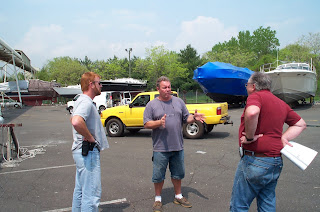
Here it is, a month since my last post. I'd love to say I've been super busy doing all the projects I slated for the winter, but confess, I cannot. The biggest project completed so far is the replacement of the 36" wheel with a 48" wheel from a consignment shop in Washington, Second Wave. Also, I've put on the bronze manufacturer's plate from Bristol Bronze.
I heartily recommend both businesses - Second Wave because they were friendly, competent, and responsive. The owner of Bristol Bronze, Roger, will talk as long as you care to about bronze, alloys, corrosion resistance, almost any metalurgy, and the proper application of metals. He's a wealth of knowledge and very entertaining. Plan to spend an hour on the phone.
 The boat is covered - the story of the $500 Fairclough cover is legend here at the marina, and if anyone cares, I'll relate it, but suffice it to say, if you're looking for something, check out the ads in Soundings Magazine. Sometimes you find the most incredible deals.
The boat is covered - the story of the $500 Fairclough cover is legend here at the marina, and if anyone cares, I'll relate it, but suffice it to say, if you're looking for something, check out the ads in Soundings Magazine. Sometimes you find the most incredible deals.The cover is easy to put on - Herb and I put the frame up in three hours even though we'd never seen it before. It takes longer than that for his on a similar boat (Passport 40). The frame came directly from Fairclough for $1260, and is constructed out of 1" galvanized conduit with special castings for connecting the rafters. It took me about three hours to put the cover on by myself. So, next year, it shouldn't take more than about 5 hours to put up. Not bad, and it pays for itself in two years (it's over $1000 to shrinkwrap my boat! Can you believe that?).
I'm off to England next week to see my sister and brother-in-law and to go narrowboating with a newly found friend. It should be interesting.
Although the winter solstice is just now coming up, meaning winter's just starting, I am already looking forward to the spring. I thought I'd get a lot more done under the cover, but I have to say, I'd rather be off the boat than on - living in institutional green lighting is not conducive to great bouts of joy. The upside, of course, is that the boat is pretty much toasty warm and very comfortable even in 20 degree weather. I have to admit to wearing socks to bed, though, because my feet are near the chain locker which is vented. But it all works out.
Living aboard is turning out to be really pleasant. I can imagine there are those who think it odd, but I do have running water, a stove, a refrigerator and so forth so it's not like I'm camping out. Oh, yes, I have a TV and DVD player which are incredible time wasters.
But really, it's winter. There's time to waste.
We've had a couple of snowstorms here, mostly remnants of the big storms in the mid-west that left so many people without power. We're expecting another big one this weekend, but should be all cleared out by Monday. Good weather for my flight on Wednesday.
I've decided to start practicing my guitar again because it's pretty clear I'm not going to get any meaningful work done on the boat. It's nice to pull it out at dock parties and do a couple of numbers. Get's 'em going every time!
When I come back from England, the days will be growing longer! I can't help but be excited about that. Sure, there's January and February, but I'm hoping (foolishly) that we'll have warm ones and I'll be about taking the cover off early March. That's only 70 days away or so.
It's nice being at a dock, I must say. Very nice. Also, very expensive. But not as expensive as owning a house, that's for sure.
One of the downsides to living aboard is that every day you see new projects you want to do - of course, they're all do-able. All it takes is money. Here's my short list for this year:
- Change my halyards to be internal giving me a spare jib and main halyard on the mainmast and a spare mizzen halyard or mizzen staysail halyard on the mizzen.
- Install all the hardware for reefing on both booms, moving the sail raising and lowering controls to the masts.
- Install a new Garhauer traveler for the main. They have a really nice one for the 424. This is sort of a gimme - it's not strictly necessary.
- Install the new deck fill fittings I purchased from Marine Parts Depot
- New sails from Somerset Sails.
- Move all the in-hull navigation lights to the pulpits and fill in the holes created. This is important for offshore sailing and for the longevity of the lights. I'm also replacing all the bulbs with LEDs from Dr. LED.
- Build new holding tank and install related equipment. Get rid of ElectroSan.
- Replace failing solar panel and install additional ones on the seahoods of the two companionways.
- Repair gelcoat on main deck.
That covers it for this year. They're all big jobs and they're not necessarily in order.
In the beginning of January, I will have finished all my paperwork for my Master's license. I've been down to the Coast Guard station in New York City and started all my stuff. I'm a pee in a cup away - that's the required drug test that I let expire. Silly me.
My friend Cory may be getting more delivery jobs and I'd like to go with him - it's an opportunity to go boating and get paid for it. I like that. And I'll get some really good offshore experience.
I guess winter is a time for reflection. Mostly because it's too damn cold to sit around outside. Still, I manage trips to the marina office to shoot the breeze with Rick and have some coffee. He's really good about that. Always a fresh pot. What could be better?
I expect to pick up a more modern digital camera this weekend so that it's not such a big deal carrying it around. My current one is 3 megapixels, and I'm looking for a 7mp one. Two years ago, that would have been $1000. Now it's less than $200.
If this post seems to be all over the map, well, that's because it is. I could go out in the cockpit and measure for my mizzen, but, well, it's hard to get myself together to do it. I'm looking forward to my little vacation. Very exciting.
If any of you are going to be on the Coventry Canal, I'll see you on the water! Otherwise, stay warm (or cool if you're in a hot place), have an extraordinary holiday season. Think about this: we'll all be out on the water real soon!






































